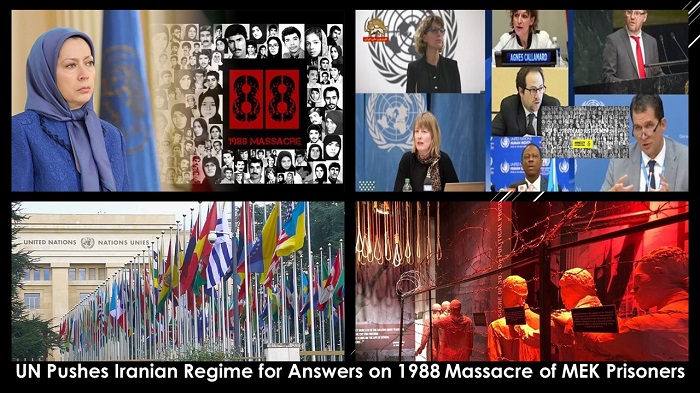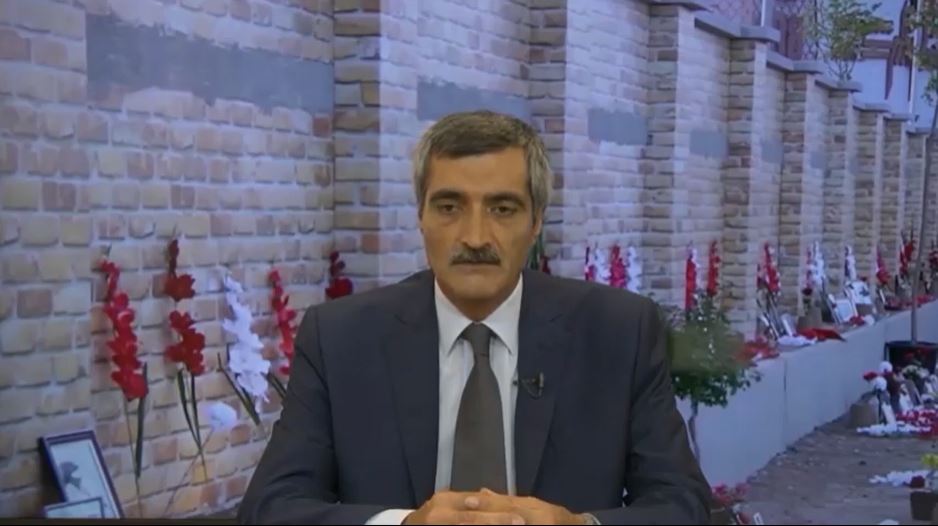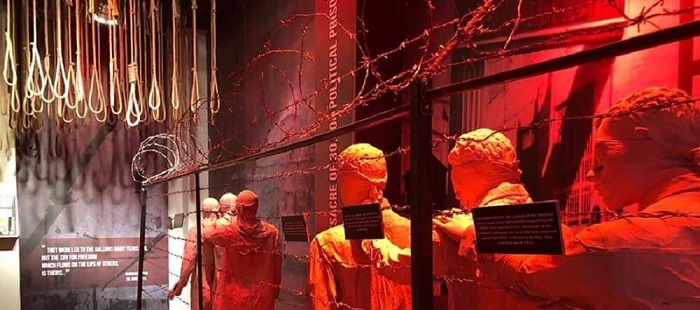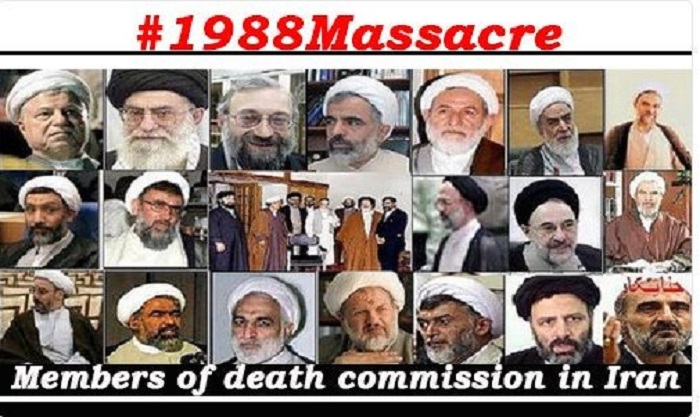
The 1988 massacre of 30,000 political prisoners, most of whom were affiliated with the main Iranian opposition movement, The People’s Mujahedin of Iran (PMOI / MEK Iran).
Eyewitness Akbar Samadi
My name is Akbar Samadi, and I was born in 1966. I was arrested at Keshavarz Boulevard in Tehran in August 1981 when the regime’s security forces brought in their forces extensively to surround the area.
After a few months, my identity was exposed by defectors at Evin and I was subjected to interrogation. In the end, I was sentenced to 10 years in prison. I spent this time in Ghezelhesar, Evin, and Gohardasht prisons.
Of course, I was not the only person who was arrested when they were under 18 years of age. There were a large number of people who were arrested at around the same age, and some of them were even executed at that young age.
During the 1988 massacre, I was sent to the Death Corridor six times. During this time, I witnessed many things. In the Death Committee, there were Nayyeri, the Sharia Judge, Eshraqi, the Prosecutor General, Ebrahim Raisi, the Deputy Prosecutor, and Mostafa Pourmohammadi, the representative of the Ministry of Intelligence.

“Pardoning Committee.”
When a prisoner came in, they would ask the prisoner their charge, and on the basis of the charge, they would issue a sentence. At that time, they would tell us that this was a “Pardoning Committee.”
And even when I entered the room, they said that we are the Pardoning Committee and we want to assess the prisoners’ situation. They asked my name, my father’s name, date of birth, and charge. When I exited the room, there was a seating area, and Reza Felani was sitting beside me. He asked me what is happening. I told him I don’t know what’s going on, but if I were to guess, I’d say that they are either going to execute us all or free us all; because the regime had accepted the ceasefire.
At this time, Ebrahim Raisi called me in again and took me to a room, and started talking to me. In reality, Ebrahim Raisi was the deputy Tehran Prosecutor, and he was there to ensure that no one would escape execution. He tried his utmost to cast as wide a net as possible for the executions, and if somehow Prosecutor Morteza Eshraqi had a different opinion about someone, Raisi would reject it.
When I went into the Death Corridor, I came across prisoners who were sitting there and waiting for execution. Of course, we didn’t know that the executions were taking place, until the afternoon, when one of the colleagues who had met the Death Committee told me the details and asked me to pass on the news to the other prisoners.

The Death Corridor
There, I told others that I have a message that I want you to listen to. We placed watchers on both ends of the Death Corridor to warn us if someone came. Then I delivered the message from my colleague, that the executions had started on July 27, 1988, in Evin and on July 30 in Gohardasht, at first prisoners from Mashhad and those with life-in-prison sentences were taken to be executed.
This is a Death Committee, and any one of us who is taken to the Death Committee would ultimately be taken to the end of the Corridor; there they will give us three pieces of paper, which include a letter to the family, power of attorney, and a will. And then, people would be taken to the Gohardasht Hosseynieh where they would be hanged.
The reaction of the prisoners … Mohammad Reza Shahid Eftekhar was sitting across from me. Mohammad Reza was a university student and if I’m not mistaken, he was studying at Polytechnic University. He said that the revolution requires sacrifices and we have to make that sacrifice. Behzad Fath Zanjani was sitting beside Mohammad Reza, and he said that the weight of the revolution is carried by certain people at every era and this time it’s our turn to carry the weight.
Since the letter of my execution sentence was left behind in the room that Raisi had called me in, I was at the Death Corridor until the end of the night. At around 11 PM, Hamid Abbasi, who is being tried as Hamid Noury currently, read out the names of 14 people. My name was not among them, neither among the people who were there nor among the people who had been executed. He went over the names once again. He went and brought the list of the names of those executed, but he still did not find my name. Then he said: “For now, you just go with them.”

We were only a few who survived
Meanwhile, for example, he read out the name of Morteza Yazdi. Morteza was in Cell 15 of Ward 3. He had been executed by mistake. In particular, Hamid Noury had read out his name wrong and they had taken him to be executed. He was executed in place of Seyyed Morteza Yazdi. Seyyed Morteza Yazdi himself was also eventually executed during that massacre.
Despite the arrests that took place in 1981 and the fact that all the prisoners were already serving their sentences, many of the people who were the same age as me (were executed), like for example Assadollah Sattar Nejad, who was serving a 15-year prison sentence and was executed in Gohardasht, or Mohsen Abdol-Hossein Rouzbehani who was serving a 10-year prison sentence and was also executed in Gohardasht, or Heydar Sadeqi Tirabadi.
In subsequent days, when we passed on the news of executions, many of the others didn’t believe it because we were all sentenced to prison terms and we were seven years in, and it was hard to believe that the regime is carrying out the executions this easily. That is why the reactions were different.
Some were saying that people are being transferred to other prisons. At this time, when some people got the news in different places, sometimes when this disbelief turned into certainty, some of them had heart attacks. The prison was empty, and there was nobody else there. We were only a few who survived and in the end, they transferred us to another ward.

We used Morse Code to communicate
There, we went over what had happened and listed the names of people who were executed. In reality, anyone who was no longer amongst us was considered to have been executed. On August 6, 1988, I was in Cell 2 of Ward 2. We used Morse Code to communicate the names of those executed. We would get the names from each cell.
In the cell below us was Mojtaba Akhgar. We communicated the names through Morse Code. The number of the names was so large that after a while each of us who was using Morse Code was replaced by another person because we would get so exhausted.
Those who ran the prison and those who were members of the IRGC and ward guards tried their utmost to increase the number of executions in any way possible. For this reason, they kept everybody in the dark and they tried their utmost to provoke prisoners so the prisoners would get mad and react, which would, in turn, become grounds for execution.
Nasserian would come every night to get the names and charges. He would draw up a list. He gave the list to Hamid Abbasi. The next morning, Abbasi would give the names to the IRGC guards and they would take the prisoners to the Death Corridor.

We were blindfolded
In the Death Corridor, we were blindfolded and would sit on the ground one meter apart. They would read the names of 10 to 15 prisoners each time, every 15 to 20 minutes, and the prisoners would be taken away.
There were many instances when all the Death Committee members, regardless of whether they had given the sentence or not, would visit and monitor and implement the execution sentences in the execution chamber. I myself witnessed this coming and going several times at least when Nayyeri, Raisi, Eshraqi, Shoushtari, and Pourmohammadi went to Hosseynieh to implement the executions.
In the Death Corridor, Nasserian would tell the IRGC guards, “go and call them, we want to get started.” All of the guards in the prison clinic, the kitchen, services, and security were dispatched. They wanted to force them to implement the executions so that later on none of these guards would be able to expose this crime. As I said, the magnitude of the crime was so huge that no one was left in prison.
One of the aspects of this massacre, regardless of the fact that it was happening inside the prisons, was the unawareness of the families outside. The families were kept in the dark about the situation inside prison for a long time because visits were suspended. Later, many mothers and fathers who found out about the execution of their kids literally died from the news or had heart attacks.

They wanted to get rid of the evidence of crimes
Gholam Reza Mashhadi Ebrahim was an only child. He was executed even though he had a heart illness. Hossein Afkhan had lost his mental balance. Incidentally, he was executed because they wanted to get rid of the evidence of crimes and torture (on his body).
Ali Haqverdi, during his imprisonment, was kept standing for about seven days straight. He was tortured in that condition and also suffered a concussion. And after that, he suffered from complications in his head. At some point, I was responsible for taking care of Ali Haqverdi. But even Ali Haqverdi, who faced this severe and serious illness, was executed during the massacre.
Or, Hamid Reza Ardestani. His feet were hit with cables so brutally during interrogations that they were so badly infected that his muscles and small toes were eventually severed.
In order to erase all evidence and traces of torture, all these people were executed.
To date, families do not even know where their kids have been buried. And this is a crime that is ongoing. Meaning that it’s not restricted to 1988. Many of the mothers spent years in Khavaran Cemetery and various burial sites to look for the remains of their loved ones. Not only have they not made any progress but they have also been harassed, pressured and tortured, and even imprisoned by the Khomeini and Khamenei regimes.

Life after the execution of our friends was really hard
For us who survived the massacre, life after the execution of our friends was really hard. We had spent years with them and we were together for a long time. In normal family life, you’d study, work, and conduct other activities, and maybe you’d spend several hours of the remainder of the 24 hours at home with friends or family or sisters and brothers and such. But we spent the entire 24 hours with each other in various conditions.
We were at each other’s side during good times and bad times. So, we couldn’t forget it. It was hard to live without them. Also, these people wanted nothing for themselves. Their only desire was freedom and prosperity. I myself was born in a relatively modest neighborhood in southern Tehran. What motivated me to join the MEK and to support it was to pursue a better life for myself, my friends, my family, and others.
We wanted nothing else. We wanted people to live in peace. But despite the fact that all these people were in prison for seven years, not only did they not reach their goal but they also sacrificed their lives. So, what remained for us was to follow in their footsteps and continue their path.
And now, in a word, this identity and this ideal are summarized in the pursuit of freedom and prosperity for the people. And naturally, it’s nothing that can be given away or exchanged with something else in a deal with others. And if anyone wants to exploit this situation for selfish reasons the reality is that they have not and will not be successful. No one can exploit the Call for Justice Movement to achieve a higher status for themselves personally.
MEK Iran (follow us on Twitter and Facebook)
and People’s Mojahedin Organization of Iran – MEK IRAN – YouTube







